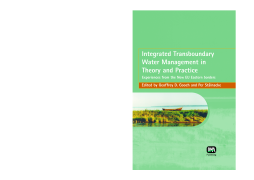
BOOK
Integrated Transboundary Water Management in Theory and Practice
Geoffrey D. Gooch | Per Stalnacke
(2006)
Additional Information
Book Details
Abstract
This book will examine and analyse the problems inherent in integrated water management in transboundary conditions. Integrated Transboundary Water Management in Theory and Practice will provide new knowledge and policy recommendations based on the experiences and results of a major 3-year interdisciplinary research project (MANTRA-East). Drawing on extensive studies of the Lake Peipsi region in Estonia and Russia, the book explores the political and social issues surrounding transboundary water management and introduces the way that qualitative-quantitative-qualitative scenarios have been used in real-life situations. The book presents conclusions and policy recommendations for integrated transboundary water management that will be invaluable to water managers, policy-makers and academic researchers working in this rapidly expanding field.
Table of Contents
| Section Title | Page | Action | Price |
|---|---|---|---|
| Integrated Transboundary Water Management in Theory and Practice | ii | ||
| Contents | vi | ||
| Preface | x | ||
| About the editors | xii | ||
| Contributors | xiv | ||
| 1. Introduction: identifying and solving problems in an integrated approach | 1 | ||
| 1.1 Introduction to recent changes in European water policy | 1 | ||
| 1.2 Transboundary water management: a particularly problematic issue | 4 | ||
| 1.3 Water management in the new EU border regions | 6 | ||
| 1.4 The problems facing transboundary cooperation in northeast Europe | 8 | ||
| 1.5 Geo-politics in the Baltic States | 9 | ||
| 1.6 Transboundary cooperation in the Baltic States | 11 | ||
| 1.7 Environmental problems in the Baltic States | 13 | ||
| 1.8 The need (and challenges) of using an integrated approach in water management | 15 | ||
| 1.9 Integration! Integration? | 17 | ||
| 1.10 Scientific and disciplinary differences | 18 | ||
| 1.11 The MANTRA-East approach | 20 | ||
| 1.12 Scenarios as a methodology for an integrated approach to water management | 21 | ||
| References | 22 | ||
| 2. The physical environment: Lake Peipsi and its drainage basin | 25 | ||
| 2.1 Introduction | 25 | ||
| 2.2 Geographical features of the Lake Peipsi and its drainage basin | 26 | ||
| 2.3 Point and non-point source pollution in the Lake Peipsi basin | 29 | ||
| 2.4 River nutrient loads in the drainage basin | 34 | ||
| 2.5 Water quality of the lake | 40 | ||
| 2.6 Concluding discussion | 51 | ||
| References | 52 | ||
| 3. The administrative and political environment | 55 | ||
| 3.1 Introduction | 55 | ||
| 3.2 The Baltic States | 56 | ||
| 3.3 Environmental management in Russia during the early 2000s | 57 | ||
| 3.4 Environmental management in Estonia in the early 2000s | 65 | ||
| 3.5 Background of the CAP | 72 | ||
| 3.6 Problems and co-operation | 80 | ||
| References | 81 | ||
| 4. Qualitative scenarios | 83 | ||
| 4.1 Introduction | 83 | ||
| 4.2 Scenarios for the Russian–Estonian border | 85 | ||
| 4.3 Discussion of the concepts and frameworks behind the scenarios | 93 | ||
| References | 100 | ||
| 5. Quantitative scenarios and modelling | 101 | ||
| 5.1 Use of models in the scenarios for Lake Peipsi | 101 | ||
| 5.2 Riverine and source emission modelling | 102 | ||
| 5.3 Implementation of the scenario storylines | 110 | ||
| 5.4 Modelled nutrient emissions and loads in the 2015–2019 period under various future scenarios | 111 | ||
| 5.5 Ecological modelling of Lake Peipsi | 116 | ||
| 5.6 Discussion and concluding remarks | 122 | ||
| References | 126 | ||
| 6. Communicating with stakeholders and the public | 127 | ||
| 6.1 Introduction | 127 | ||
| 6.2 Managing transboundary waters on the European Union external borders | 131 | ||
| 6.3 Environmental information for end users | 133 | ||
| 6.4 Development and partial implementation of an information and communication strategy for the Lake Peipsi region | 139 | ||
| 6.5 Summary | 146 | ||
| References | 147 | ||
| 7. The way ahead for transboundary integrated water management? | 149 | ||
| 7.1 Introduction | 149 | ||
| 7.2 Public, political, and administrative information for transboundary water management | 150 | ||
| 7.3 Natural scientific information for transboundary water management | 152 | ||
| 7.4 The water framework directive as a tool for transboundary water management? | 153 | ||
| 7.5 Use of models in the scenarios for Lake Peipsi | 156 | ||
| 7.6 Institutional frameworks and water policy | 158 | ||
| 7.7 Conclusions and recommendations | 160 | ||
| 7.8 Practical recommendations | 162 | ||
| References | 166 | ||
| Index | 169 |
